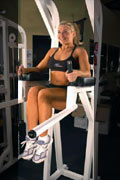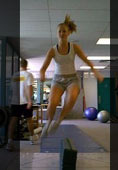Introduction
It is a known fact that the trunk is highly involved in all major movements in softball. The trunk also plays a key role in the generation of rotational power, necessary for hitting, throwing and pitching. Every softball player needs a strong center of power not only to be successful on the field but also to prevent injuries. This is why proper abdominal training is so important.
Abdominal Anatomy and Muscle Function
The abdominal region is often referred to as the “core”. The “core” is more than just the rectus abdominis (“six-pack” muscle). The definition of the core varies greatly within the scientific community but according to many exercise specialists, the core can be defined as the lower trunk musculature. The major muscles of the lower trunk musculature are the rectus abdominis, external obliques, internal obliques, transversus abdominis (deep abdominal muscle) and erector spinae (lower back muscle).
The central nervous system, responsible for muscle activation, is programmed to use various muscles in different roles to produce a movement. Muscles involved in a movement can be classified as “movers” or “stabilizers”. The primary role of movers is to produce the movement while the role of stabilizers is to stabilize the joints and the spine during a movement. In healthy athletes, the stabilizers should be firing before the movers do.
The erector spinae and rectus abdominis are movers while the transversus abdominis acts as a “stabilizer”. The internal and external obliques are primary movers but can also act as stabilizers depending on the movement.
Core Conditioning vs Abdominal Training
One of the concepts that create a lot of confusion in the strength and conditioning field is the difference between core conditioning and abdominal training. For many people, this is the same thing. However, most experts agree that there is a difference. Most of the influence in abdominal training comes from the bodybuilding field where the goal is to build hypertrophy and definition in the movers. Core conditioning is more about training the stabilizers, developing functional strength and establishing a proper sequence of muscle firing patterns in the entire abdominal area. In other words, training the abs for aesthetic purposes vs. training the abs for function and performance.
The main differences between traditional abdominal training and core conditioning are (a) the stabilization factor and (b) the training of the trunk musculature as a unit. Most bodybuilders and fitness enthusiasts do an endless amount of trunk activities but do very little to teach the core how to stabilize during a movement. Traditional abdominal training does not target the transversus abdominis (deep abdominal muscle), which plays an important role in stabilizing the entire trunk.
Athletes will most often recruit the rectus abdominis (“six-pack” muscle) to do the job of stabilizing, which it is not designed to do. This is often as a result of overtraining the “movers” in an isolated manner while neglecting to train the trunk as a unit. This leaves softball athletes at a higher risk of injuries with poor posture, stability and balance while not maximizing movement efficiency and performance. We have to retrain these stabilizers muscles to have the ability to contract in the right pattern and at the right intensity to meet the high demands placed on them.
The role of core stabilization in athletic performance is to reduce the waste of energy and to maximize its transfer from the lower body to the upper body. In sprinting, the arm action creates a tremendous amount of rotational force on the trunk while the arms try to propel the body forward. A strong and stable trunk helps to counteract this rotational force and allows the energy not to be wasted and to be properly used. The weaker the core, the more energy is lost in the rotation of the trunk. This energy saving concept applies to the lower body as well. The legs drive off the ground and the energy travels up the legs through the core to the upper body. A weak core will cause some of this energy to be lost creating a slower runner.
This concept applies to any athletic move that requires speed, power, agility and quickness. In other words, it applies to everything a softball player does on the field. A strong and stable core will also allow an athlete to change direction more quickly. As an athlete decelerates, the upper body is still moving forward. A strong core will help decelerate the upper body allowing a faster change of direction. This is similar to wearing a seat belt in a car accident. Wearing a seat belt in a car accident (strong and stable core) will maintain the body in place while not wearing a seat belt in an accident (unstable and weak core) is likely to propel the body in space.
A sound core conditioning program must look beyond crunches, sit-ups, leg lifts and other conventional abdominal exercises. It has to be comprised of exercises that force the core area to stabilize while producing a movement. The key point in all these activities is to activate the stabilizers first and maintain their activation while the prime movers are recruited to produce a movement. This should not only apply to abdominal exercises but to all exercises that an athlete has to perform.

Periodization Of Core Conditioning
The key to optimal athletic performance is to develop the various muscular qualities in the right order or in a sound progression (Bompa, 1994). The development of functional core for softball players should be done following the continuum of stability – strength – power.
Core Stability
Core stability is a relatively new concept in the strength and conditioning field. It originates from the rehabilitation field where therapists and researchers were interested in understanding the role played by the trunk muscles on the lumbar spine. The goal was to improve treatment of low back pain. By studying the anatomy and function of each trunk muscle, researchers were able to determine the role of each muscle and understand how the lumbar spine is supported.
Core stability is the ability to contract the lower deep abdominal muscles to help support the trunk in dynamic and static positions, enhancing balance, stability, posture and movement efficiency (Vogel, 2001). The core is the body’s center of power. Regular conditioning of the core muscles is vital to prevent injuries, correcting posture and ensuring more efficient and functional movement patterns. A dysfunctional core will lead to dysfunctional movements.
In short, core stability will provide back support and will enhance the execution of all athletic moves.
Core stability must serve as a foundation to build core strength and power for enhancing performance. Core stability is often the missing link in abdominal training.

Core Strength
Once the trunk is stable, one has to develop core strength. To improve performance, an athlete should seek the development of functional strength in the abdominal area. Functional strength can be defined as “usable strength”. It is the type of strength that is required in order to be strong and stable while performing daily activities or athletic moves. To develop functional strength, you have to perform functional exercises. Developing strength through conventional abdominal isolation exercises will do very little to increase performance because they are developing “dysfunctional strength”. To have functional abs, both prime movers and stabilizers must be trained together as a unit rather than in an isolated manner.
Core Power
At this point, strength must be converted into power. Power is the ability to generate high forces in short periods of time. Every action in softball requires power. This is mostly done through medicine ball exercises.
Conclusion
Core conditioning is a more integrated and complete approach to abdominal training. It should be the preferred mode of training when seeking an increase in performance. It will not only improve a player’s performance significantly but also reduce the amount of injuries by providing the spine and the joints with more stability. Unfortunately, most softball athletes are still exposed to traditional abdominal training that does little for them in terms of performance. In the next article, I will present various innovative and sport specific core conditioning exercises.